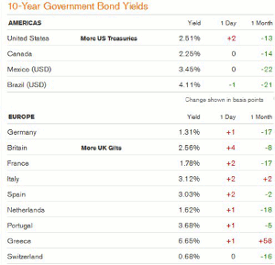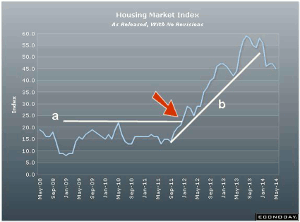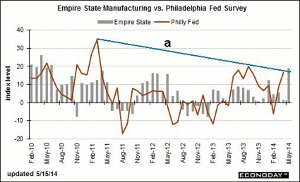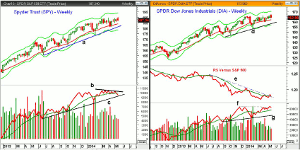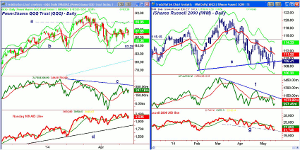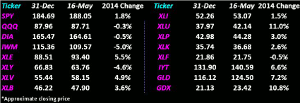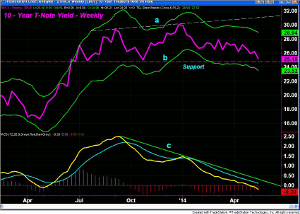Continued volatility in the market is grinding investors and traders down, with some starting to doubt their strategies in frustration, so MoneyShow's Tom Aspray analyzes whether or not it's wise to switch game plans at this point.
It was a wide-ranging week for the stock market, while bond prices kept rising as yields hit new six-month lows. Though volume for the week was low, the daily volume was a bit higher on the down days.
The sharp selloff was blamed in part on the comments by a well-known hedge fund manager while others guessed that the “sell in May crowd” decided to pick the middle of the month to dump their stocks.
In any case, many investors and traders seem to be risk adverse as we head into the often-difficult summer months. The decline in yields has been a global phenomenon as this table from Bloomberg illustrates. It shows that while the yield on the US 10-year T-note has dropped 11 basis points in the past month, those in Germany and France have declined 17 points.
Even more surprising is the 22 basis points decline in the 10-year bonds in Mexico and Brazil. On a yearly basis, the bonds of Portugal and Greece have declined over 160 basis points in the past year.
The yields on the 10- and 30-year US Treasuries have not yet dropped below their key support levels but they are much closer now than they were last week. A break of these levels would indicate a further drop in yields but I would still not chase the long side of the bond market.
If you have been shortening the maturity of your bond portfolio as I first recommended a year ago, you shouldn't change the structure of your bond portfolio now. If rates drop further, it will lag the performance of a longer-maturity portfolio. However, the outlook for rates over the next few months is uncertain, and I think yields are likely to be significantly higher a year from now.
This interesting table from CXO Advisory provides a different spin on the well-known data that leads some to sell in May and then buy stocks in November. As you can see, the performance during the May-October period was worse in even years and 10 times better in odd years.
Since I focus on market timing, along with identifying market-leading sectors and stocks, I have never been a big follower of this approach. Oftentimes, there are good buying opportunities during the summer months.
For example, in early June of 2012, the technical studies gave strong positive signals. Over the next six months, the S&P 500 gained 9.7% but if you bought at the start of November you finished the year with a slightly loss.
The NYSE Advance/Decline line shows no signs of an intermediate-term top, so I would recommend a high allocation to stocks unless you need the funds before the end of the year. Those who watch their portfolios nervously throughout the year may consider raising an additional 10-15% in cash on the next market rally. That way you will have more cash to invest this fall.
Globally, the concern has shifted more to a fear of deflation but it seems pretty certain that the ECB will lower rates in June as the pressures are mounting. A Financial Times editorial argued that "Draghi must tackle threat of deflation."
NEXT PAGE: What to Watch
|pagebreak|Last week’s GDP numbers reflected stronger than expected growth for Germany and Japan while Italy was weaker than expected. The next reading on the US GDP does not come until May 29.
Investors seemed to focus last week on the economic data that was disappointing. The Retail Sales last Tuesday were up an anemic 0.1% when most were expecting 0.4%. These disappointing numbers for April will make May’s numbers even more important.
The data for the housing market was mixed as the Housing Market Index declined but expectations for future sales were strong. The chart shows the breakout above resistance, line a, that I pointed out in 2012. The short-term uptrend, line b, has been broken but as long as the HMI does not drop below the low from the spring of 2013, the trend will remain positive.
The housing stocks are still acting weak as the iShares Home Construction ETF (ITB) made new correction lows last Thursday. The Housing Starts last Friday showed an unexpected 13.2% gain in April and they were up 26.4% on a year-to-year basis.
Last Thursday’s disappointing Industrial Production data did not provide any confidence to investors who were already worried about the strength of the economy. Largely ignored was the 19-point surge in the Empire State Manufacturing Survey (see chart) and the Philly Fed Survey kept up April’s trend of stronger growth. The downtrend in the Philly Fed data (line a) is close to being broken.
The weaker than expected preliminary consumer sentiment reading form the University of Michigan was disappointing but it is the final monthly numbers that are more important.
The economic calendar is light early this week with Fed Chair Janet Yellen giving a commencement speech on Wednesday and the FOMC minutes will also be released that afternoon.
Thursday will be the key day as in addition to the jobless claims we get the PMI Flash Manufacturing Index , Leading Indicators, and Existing Home Sales. The Pending Home Sales report for April comes out on Friday.
What to Watch
The Spyder Trust (SPY), NYSE Composite (NYA), and SPDR Dow Industrials (DIA) finally got the upside breakout that I was looking for but it was mostly negated by the selling last Wednesday and Thursday.
The market turned higher in the last 90 minutes of trading on Friday, which helped to reduce much of the losses from early in the week as both the NYSE Composite (NYA) and Spyder Trust (SPY) were flat for the week in late trading.
As I noted in Friday’s technical review, many investors are wondering whether the market is destined to test the lower boundaries of the trading range, which has contained prices for much of the year.
The oversold reading from the Arms Index on Thursday was consistent with a short-term selling climax. This favors a further rebound early this week but it will need to be watched closely. The weekly analysis of the market internals on the NYSE Composite (NYA) is clearly positive while the weekly OBV on the Spyder Trust (SPY) has deteriorated.
The low readings of the VIX is not generating any strong warnings, and while the individual investor turned a bit more bullish last week (up to 33.2% from 28.3%), they are at levels closer to a market bottom than a top.
It was another crazy week for earnings as J.C. Penney Company, Inc. (JCP) surprised the market as it was up over 145 on Friday and was joined by a 13% gain in Nordstrom Inc. (JWN) . On the other side of the coin, there was World Wrestling Entertainment (WWE), which was down over 43%.
The five-day MA of the % of S&P 500 stocks above their 50-day MAs has stayed in its narrow range as it was at 58% Thursday, which is just below the mean of 63%. It is holding above the recent lows but a drop below 46% would be consistent with a drop in the S&P to the lower boundaries of its trading range.
NEXT PAGE: Stocks
|pagebreak|The weekly chart NYSE Composite (NYA) will close the week above the monthly pivot at 10,522.
The monthly projected low is at 10,375, which is very close to the 20-week EMA at 10,359. The quarterly pivot is at 10,270 with additional support in the 9900-10,000 area. Of course, the NYSE dropped to a low of 9732 in February but I think it would take the completion of a more significant top before we would go that low.
There is initial daily gap resistance from last week at 10,637-10,647 with further at 10,700.
The weekly NYSE Advance/Decline made a new high three weeks ago and is holding near its highs. It is well above the rising WMA as it has been since the end of last year.
The weekly OBV made a slightly lower high in early May and is now testing its rising WMA. This makes the close this week quite important. The OBV has long-term support now at line c.
S&P 500
The weekly chart of the Spyder Trust (SPY) shows the narrow range over the past four weeks, which is a cautionary sign. As I noted on Friday, a daily close below the May 7 low of 186.01 will increase the odds of a drop to the minor 38.2% Fibonacci support at $183.75. The 20-week EMA is at $184.14.
This is just above the quarterly pivot at $182.70 with the 50% support at $181.69. The weekly uptrend is at $181.72 with the starc- band much lower at $178.43.
There is first resistance now at last Thursday’s opening price of $188.67 and then at Wednesday high of $189.88.
The S&P 500 A/D after making a new high on Monday looks ready to close the week below its WMA and the recent lows.
The weekly on-balance volume (OBV) has dropped below its WMA after diverging from prices, line b, since February. A decisive break of the uptrend, line c, would be a sign that a more important top could be forming.
The daily OBV (not shown) does look stronger as it made a new high last week and is just slightly below its rising WMA. It therefore does not yet show a completed top formation.
Dow Industrials
The SPDR Dow Industrials (DIA) made a new weekly and all-time high last week before closing lower. The 20-week EMA is at $162.10 with the April low at $159.88. There is further weekly support, line d, at $158.33 with the starc- band at $156.92.
The weekly relative performance is close to dropping below its WMA. The downtrend, line e, was broken a few weeks ago. The daily RS analysis (not shown) still looks as though it has completed a bottom formation.
The weekly OBV was able to break out above its prior highs, line f, before it turned lower. It is well above its WMA and has long-term support at line g.
The monthly pivot is now being tested with the monthly projected pivot support at $161.49.
Nasdaq-100
The PowerShares QQQ Trust (QQQ) dropped back below its 20-day EMA last Thursday before stabilizing above the monthly pivot of $86.78. There is further support at $85.50-$85.85 with the daily starc- band at $85.26. There is long-term support at $83.28, line b.
There is minor resistance now at last Tuesday's doji high of $88.61, and a move above this level would reverse last Wednesday’s daily LCD sell signal.
The daily OBV turned up Friday but is still below its WMA with more important resistance at the downtrend, line c.
The Nasdaq 100 A/D made a marginal new high last week and is clearly acting stronger than prices. This may be a sign that just a few of the Nasdaq 100 stocks are taking the index lower. The A/D line did close the week below its WMA with long-term support at line d.
Russell 2000
The iShares Russell 2000 Index (IWM) continues to act the weakest as it broke support at line e last week. It is down 9.5% from the March 4 high at $120.27. It has been below its quarterly pivot at $114.53 since April 11.
The quarterly projected pivot support is at $108.80 was also broken last week with the daily starc- band at $106.29 The monthly projected pivot support is at $103.22.
The declining 20-day EMA is at $111.18 with the monthly pivot at $113.04. There is more important resistance now at $115.05.
The daily OBV has not yet made new correction lows and is trying to run up. It needs to move above its downtrend, line f, and the previous peak to turn positive.
The Russell 2000 A/D continues to show a pattern of lower highs and lower lows, which is a sign of weakness.
NEXT PAGE: Sector Focus, Commodities, and Tom's Outlook
|pagebreak|Sector Focus
The iShares Dow Jones Transportation (IYT) was one of the bright spots last week as it made a new high at $141.69 and rebounded nicely on Friday. The weekly starc+ band is now at $144.51, which is just above the monthly projected pivot resistance at $144.15.
The weekly and daily relative performance are both rising sharply, confirming that it is still a market leader. The weekly OBV closed at a new high last week.
There is initial support now at $138 with the monthly pivot at $135.97.
The Spyder Trust (SPY) is alone in positive territory while the SPDR Dow Industrials (DIA) and the PowerShares QQQ Trust (QQQ) are still down slightly. The iShares Russell 2000 Index (IWM) is still down over 5% for the year.
The sector ETFs stabilized on Friday but were still lower for the week. The Select SPDR Utilities (XLU) and the Select SPDR Energy (XLE) are still leading, up 10.8% and 5.4% respectively.
Only the Select SPDR Financials (XLF) and Select SPDR Consumer Discretionary (XLY) are still negative for the year. The XLY is still part of the Charts in Play portfolio but it needs to close above $65 to complete its bottom formation.
The Select SPDR Consumer Staples (XLP) made another new high last week and is up 3% for the year. The Select SPDR Materials (XLB) is doing a bit better as it is up close to 3.6%.
The Select SPDR Health Care (XLV) is up 4.9% for the year but is still well below the highs it made in early March.
Bond Market
The weekly chart of the 10-year T-note yield shows the decline last week though it closed at 2.518% and well above the week’s low. It is still above the key support at line b with the starc- band at 2.352%. The weekly MACD is still declining, and it would take several weeks before it could turn positive.
Crude Oil
Crude oil closed with strong gains as it was up $2.34 basis the July contract. The quarterly pivot at 97.57 was approached two weeks ago but appears to have held. The weekly OBV as I noted a few weeks ago stayed positive during the correction and still looks strong.
Precious Metals
I did not like the way that either the SPDR Gold Trust (GLD) or the Market Vectors Gold Miners ETF (GDX) acted last week as they have failed to rally after the positive signals from a few weeks ago. In last Wednesday’s Gold Miners Fail to Launch I recommended closing out the long positions in GDX for a small profit.
The Week Ahead
The action last week had quite a few investors and analysts shaking their heads, and in light of the deterioration in some of the weekly studies, a more cautious approach is warranted.
We are still long both the Spyder Trust (SPY) and PowerShares QQQ Trust (QQQ) but I will be watching them closely early in the week in case the rally from Friday’s lows loses upside momentum.
I would continue to stay with the long-term holdings in both an S&P 500 tracking ETF or mutual fund as well as the Vanguard Emerging Markets (VWO), which actually closed the week with nice gains. It is certainly giving different signals about the global economy than the US market.
The dollar cost averaging positions in the S&P 500-tracking ETF that I discussed in the January 24 column, A Path to Investing Success in 2014, should have been completed on Friday, May 16.
If we do see a rally failure early in the week, I will likely take some more profits in the Charts in Play portfolio but I'm not sure that I will be recommending a hedge with an inverse ETF as they have not been performing like one might expect.
Look at your portfolio closely this weekend for signs of deterioration and then act accordingly.
Editor’s Note: I will be out of town next week and the next regular Week Ahead column will be published on May 30.
Don't forget to read Tom's latest Trading Lesson, Mastering the Basics of Stop Placement.

